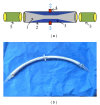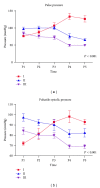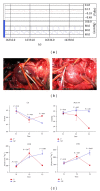Shear stress, energy losses, and costs: a resolved dilemma of pulsatile cardiac assist devices
- PMID: 24511541
- PMCID: PMC3913384
- DOI: 10.1155/2014/651769
Shear stress, energy losses, and costs: a resolved dilemma of pulsatile cardiac assist devices
Abstract
Cardiac assist devices (CAD) cause endothelial dysfunction with considerable morbidity. Employment of pulsatile CAD remains controversial due to inadequate perfusion curves and costs. Alternatively, we are proposing a new concept of pulsatile CAD based on a fundamental revision of the entire circulatory system in correspondence with the physiopathology and law of physics. It concerns a double lumen disposable tube device that could be adapted to conventional cardiopulmonary bypass (CPB) and/or CAD, for inducing a homogenous, downstream pulsatile perfusion mode with lower energy losses. In this study, the device's prototypes were tested in a simulated conventional pediatric CPB circuit for energy losses and as a left ventricular assist device (LVAD) in ischemic piglets model for endothelial shear stress (ESS) evaluations. In conclusion and according to the study results the pulsatile tube was successfully capable of transforming a conventional CPB and/or CAD steady flow into a pulsatile perfusion mode, with nearly physiologic pulse pressure and lower energy losses. This represents a cost-effective promising method with low mortality and morbidity, especially in fragile cardiac patients.
Figures








Similar articles
-
Pediatric physiologic pulsatile pump enhances cerebral and renal blood flow during and after cardiopulmonary bypass.Artif Organs. 2002 Nov;26(11):919-23. doi: 10.1046/j.1525-1594.2002.07127.x. Artif Organs. 2002. PMID: 12406143
-
A novel rotary pulsatile flow pump for cardiopulmonary bypass.ASAIO J. 2014 May-Jun;60(3):322-8. doi: 10.1097/MAT.0000000000000058. ASAIO J. 2014. PMID: 24625536 Free PMC article.
-
Precise quantification of pulsatility is a necessity for direct comparisons of six different pediatric heart-lung machines in a neonatal CPB model.ASAIO J. 2005 Sep-Oct;51(5):600-3. doi: 10.1097/01.mat.0000177780.39577.d2. ASAIO J. 2005. PMID: 16322724
-
Is a pulse absolutely necessary during cardiopulmonary bypass?Expert Rev Med Devices. 2017 Jan;14(1):27-35. doi: 10.1080/17434440.2017.1265445. Epub 2016 Dec 15. Expert Rev Med Devices. 2017. PMID: 27892719 Review.
-
Pulsatile perfusion during cardiopulmonary bypass procedures in neonates, infants, and small children.ASAIO J. 2007 Nov-Dec;53(6):706-9. doi: 10.1097/MAT.0b013e318158e3f9. ASAIO J. 2007. PMID: 18043152 Review.
Cited by
-
Endothelial shear stress enhancements: a potential solution for critically ill Covid-19 patients.Biomed Eng Online. 2020 Dec 3;19(1):91. doi: 10.1186/s12938-020-00835-7. Biomed Eng Online. 2020. PMID: 33272285 Free PMC article.
References
-
- Diehl P, Aleker M, Helbing T, et al. Enhanced microparticles in ventricular assist device patients predict platelet, leukocyte and endothelial cell activation. Interactive CardioVasc Thoracic Surgery. 2010;11:133–137. - PubMed
-
- Pieske B. Reverse remodeling in heart failure—fact or fiction? European Heart Journal, Supplement. 2004;6:D66–D78.
-
- Habazettl H, Kukucka M, Weng YG, et al. Arteriolar blood flow pulsatility in a patient before and after implantation of an axial flow pump. Annals of Thoracic Surgery. 2006;81(3):1109–1111. - PubMed
-
- McHugh J, Cheek DJ. Nitric oxide and regulation of vascular tone: pharmacological and physiological considerations. The American Journal of Critical Care. 1998;7(2):131–140. - PubMed
-
- Thorin E, Nguyen T-D, Bouthillier A. Control of vascular tone by endogenous endothelin-1 in human pial arteries. Stroke. 1998;29(1):175–180. - PubMed
MeSH terms
LinkOut - more resources
Full Text Sources
Other Literature Sources
Medical
Miscellaneous

